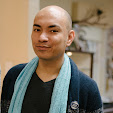
Normally on Thursday evenings, I have my Abnormal Psychology class. However, my professor felt that after we watched a short video on Freud, we might want to swing over to the main building to be apart of the audience of a symposium called, Voices of War: The Artist's Perspective.
Here is what the press release had to say:
To consider the Artist's perspective on war, a distinguished panel of SVA Alumni and current students with military service during the Iraq war/era will share their experiences, insights and observations regarding this controversial adventure. Participants will also discuss the art they have created as a consequence of their service. Come listen and learn from those who know war best.
Our class trekked through the rain, but we eventually got to the crowded and hot secondary lecture room usually reserved for film students.
I'm not sure if I would have gone to the lecture had we not went as a class. Apparently we're supposed to study post-traumatic stress syndrome next week and it was supposed to be of interest as a possible paper topic.
I usually try to steer clear of political subjects. Mainly because there is so much conflict that usually arises and I've already had my fair share of political nastiness. It's true that you might catch me glancing through various political articles to keep some what abreast of what is happening in our nation or across the globe, but it is not a priority of mine.
The symposium, I thought was flat. Of course I had to leave a little early and missed the Q & A session, but I felt that some of the speakers should have prepared better and that many of the speakers were simply not engaging.
Petty Officer Brian Neilson, whom I'm apparently graduating with, read a prepared speech. For some reason, I got a flashback of high school with the selected senior speakers. It was both awkward and sounded as though it were written as a homework assignment for an English class. I also thought that his work was of fairly banal quality. I guess I'm tired of seeing back-lit photographs of photographer's significant others standing in front of windows. Or of silhouettes of army men. I think the job of a graphic designer and photographer is to push the boundaries of what has been already done and engage the viewer and entice them.
Petty Officier Richard Hayden didn't show up.
Corporal James Martin sort of just went up there and talked about how he got drunk a lot and how Iraq was "boring" and how he'd go to war again, not knowing why, just "to die for someone else with kids, maybe." He didn't even show examples of his work. I thought the basis of the symposium was to show artists who've gone to war who've developed work as a result of their personal experiences.
Major Peter Buotte (who did the piece featured above) was actually a pretty decent speaker. I imagine that it's because he's well-educated, a translator and organizer of various international projects. He also had a pretty interesting slideshow of his works in Iraq as a rebuilder of schools and social programs. I think it was more engaging because the magnitude of what he worked on was on a larger scale. It wasn't simply, "They fired guns at us." It was about effecting positive change in a war-torn country and making it last.
I don't love his work, but I definitely respect where it comes from and has developed from an art historical view. It also is a little bit smarter than some of the work we've looked at. Martin's work, I think was too cut and dry and almost propagandist. Buotte's work dealt with a lot of different conflicting emotions and ideas, about power, struggle and the ways in which we mourn.
I will have to ask some of my classmates who stayed what they thought of the rest of the symposium. I had to leave just as Buotte was finishing up.















No comments:
Post a Comment